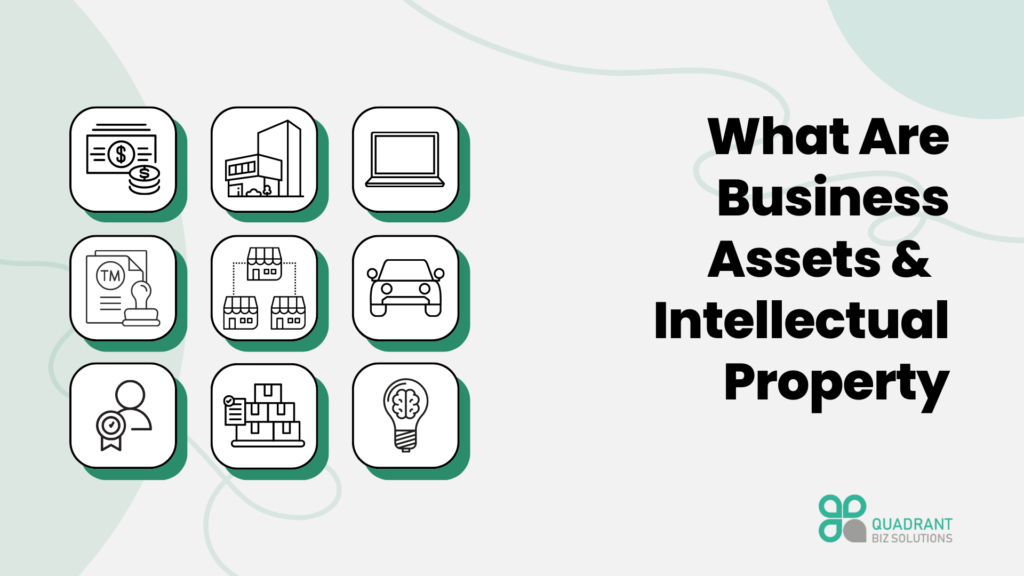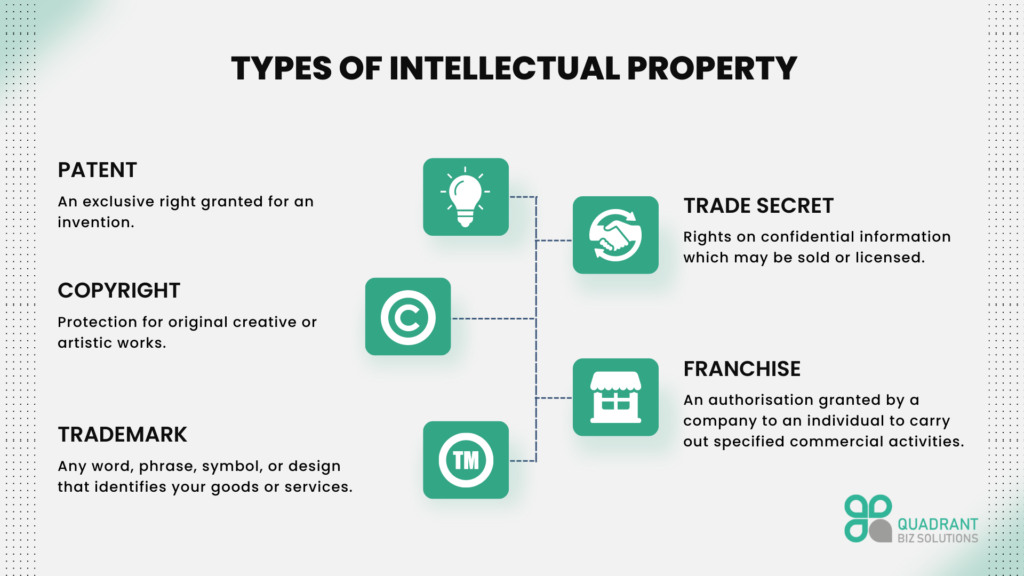
Business Assets
Business assets are anything of value to a company that helps support and promote company productivity, efficiency and revenue. They include both tangible and intangible assets.
It’s important to understand the nature and extent of your business assets and, more importantly, how to protect them and your business from infringement, theft or violation.
Tangible assets
Tangible assets are assets with monetary value. They are the physical assets that your business owns. Some examples of tangible business assets are:
- Cash reserves
- Inventory
- Office furniture and machinery
- Company-owned cars
- Land
- Buildings
Intangible assets
Intangible assets are non-physical resources that can potentially add value to a company’s worth.
- Intellectual property: This can include but is not limited to items such as: Designs, Brand/Logo, Slogan, Catchphrase etc
- Data/Information, Software etc
- Goodwill
- Knowledge and expertise
Intellectual Property As A Business Asset
One of the most important business assets is intellectual property (IP). It helps set your business apart versus your competitors. It also has an intrinsic value, which you deserve to be compensated for – these are your proprietary creations.

Patent
A patent carries legal protection that excludes others from making and distributing your invention unless you have given them the licence. To obtain a patent, technical information about the invention must be disclosed to the public in a patent application.
Technology and software companies often have patents for their designs. For example, Apple Inc invented and patented the design of iPhone in 2007. The patent covers the device design, including the rectangular shape with rounded corners and bezel-free display.
Copyright
Copyright refers to the legal right of the owner of IP. It provides authors and creators of original material the exclusive right to use, copy, or duplicate their material. For example, authors of books have their works copyrighted. A copyright also states that the original creators can grant anyone authorisation through a licensing agreement to use the work.
Trademark
A trademark is a symbol, phrase, or insignia that is recognisable and represents a product that legally separates it from other products. A trademark is exclusively assigned to a company, meaning the company owns the trademark so that no others may use or copy it. For example, the McDonald’s golden arches design is an example of a registered trademark owned by McDonald’s.
Trade secret
Trade secrets are IP rights on confidential information. It is a process, practice or data that is not public information, which provides an economic benefit or advantage to the company. If this IP is copied or, worse still, stolen, this can result in economic loss to the company. Therefore, it is vital to take stringent measures to protect these assets.
To qualify as a trade secret, the information must be:
- Commercially valuable,
- Be known only to a limited group of persons, and
- Be subject to reasonable steps taken by the rightful holder to keep it a secret.
Examples of trade secrets could be a design, pattern, recipe, formula, or proprietary process.
Franchise
A franchise is a method of distributing products or services. This involves a franchisor – the entity that establishes the brand’s trade name, proprietary knowledge, and processes, and a franchisee – the person or entity that pays an initial fee for the right to do business under the franchisor’s name and system.
Examples of popular franchise businesses include McDonald’s, 7-Eleven, and KFC. Read our article on the pros and cons of franchising here.
Tips For Protecting Intellectual Property
IP is one of the most important intangible assets, hence, there must be proper processes in place to protect your IP and restrict others from copying, using, selling or distributing, and profiting from it without your consent.
Here are four different ways to protect your IP.
Implement Non-Disclosure Agreements for employees and partners
A non-disclosure agreement (NDA) restricts any involved party from sharing information defined by the terms of the agreement. It will help to strengthen your defences against violations like trade secret misappropriation, where an employee could share sensitive IP-related information with outsiders.
Implement security measures
Employees should be briefed about and comply with the company’s IP protocols and practices. The IP data protection policy should specify which data must be secured, who has access to it, and how it must be protected. It should also specify how the confidential data regarding IP should be conveyed and how it should be disposed of/deleted when no longer required. For example, employees should only be able to access the company network over a VPN (Virtual Private Network) when using public Wi-Fi, in order to prevent confidential data being leaked as it travels over the public internet.
Here are some of the most popular VPNs you may consider using for your business:
Avoid joint ownership
Where possible, avoid joint ownership of IP as it could make it difficult to protect. This is because in a joint ownership, every owning party may copy, recreate, distribute, or take whatever action they want with the IP without consulting the other owners – which may create more problems than protecting the IP in the first place.
Apply for trademark, patent, and copyright
Companies can protect their IP by registering a trademark, patent, or copyright. These protection measures grant the company exclusive rights to its creations, especially regarding the commercial gains from use. Furthermore, it allows the company to obstruct competing goods, deter new entrants, and pave the way for future market share via technological advancements.
Final thoughts
Companies of all sizes are at risk of having their unique ideas, proprietary products and services, and company-specific data or information copied or stolen. Hence, it is vital to protect the business assets that are integral to the core services of your business and overall long-term viability.
The Intellectual Property Corporation of Malaysia (MyIPO) is a useful source of information on the different types of IP protection available and the steps and criteria involved. Click here to read more: https://www.myipo.gov.my/en/home/ Once you are ready to apply for IP protection in Malaysia, you will need to file an application by filling in Form TM5.
In the meantime, if you are unsure on any aspects of protecting your assets, the team at Quadrant Biz Solutions can guide you on where to begin.
